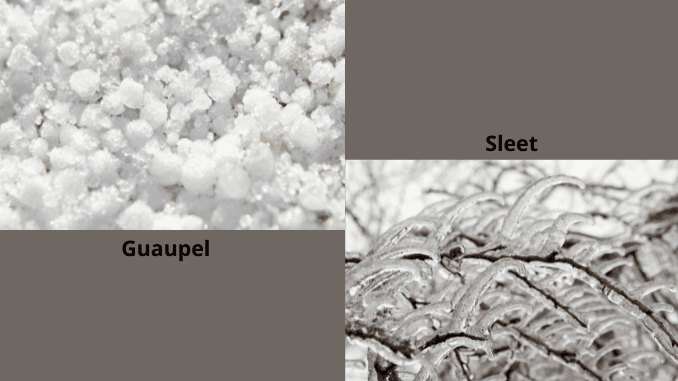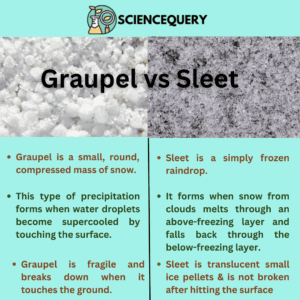
Introduction
Graupel and sleet both are forms of precipitation that come under the same category frozen precipitation. But there are some differences between them that we are going to discuss in this topic graupel vs sleet.
- Graupel is a small, round, compressed mass of snow.
- It is a snow globule or soft hail.
- This type of precipitation forms when water droplets become supercooled by touching the surface.
- Thus, resulting in approximately 0.08-0.2 inch small pellets.
- Meteorologists define graupel as small hail and different in both size and shape.
- Sleet is a simply frozen raindrop.
- It forms when the snow comes from clouds then melts through an above-freezing layer and falls back through the below-freezing layer.
- Despite some resemblance to hail, there are minor differences between them.
- Where sleet is translucent small ice pellets and is not broken after hitting the surface, the graupel is fragile and breaks down when it touches the ground.
Sleet forms during winter storms and the snowflakes partially melt and refreeze subsequently before hitting the surface. Graupel is formed when the water droplets freeze by touching the surface of snowflakes (1) & (4).

What is graupel?
Meaning
Graupel is a German term meaning pearl barley. It was first seen in an 1889 weather report and has been included in metrology.
Definition
Graupel is referred to as a small and round mass of snow. It is a form of precipitation that forms when water droplets become supercooled after touching the surface of snowflakes. The circumference of snowflakes is approximately 0.08-0.2 inches. It has a milky white color and is small in size and shape.
According to the World Meteorological Organization, Graupel is a tiny pellet of snow that breaks down after touching the surface.
Graupel is commonly seen in high-altitude climates and is more dense and granular than ordinary snow (3).
Interesting facts about graupel
- Graupel is usually a winter storm.
- It falls especially in convective springs at higher altitudes.
- The Meter code for graupel is GS.
- It is also called soft hail, or snow pellets.
- Graupels are usually brittle, partially sized, and in a mixture of precipitation, they usually combine with ice crystals instead of snow.
- It is thicker than normal snow.
- Macroscopically, the graupel resembles a smaller size of polystyrene (2).
Process of graupel formation
Graupel is formed when supercooled water droplets become frozen after touching the cold surface, resulting in approximately 2 to 5 mm small pellets. Due to some atmospheric activity, ice crystals meet with super cool water droplets and transform into snowflakes. After touching the surface or hitting the surface, they usually break down and it is referred to as graupel. It is commonly seen in high-altitude climates and is more dense and granular than ordinary snow. The process of graupel formation is mentioned below.
1. Snow forms in the atmosphere.
2. Then those snow crystals fall through a layer of supercooled water droplets.
3. After that the droplets become frozen or rime and form into snowflakes.
4. Then the snowflakes fall down onto the surface and are crushed.
5. Unlike sleet they are fragile in character (4).
What is Sleet?
Sleet is a simply frozen raindrop. It forms when the snow comes from clouds then melts through an above-freezing layer and falls back through the below-freezing layer. This type of precipitation is partially melted snow and rain which fall together on the earth’s surface. It is partially frozen but not crystalline.
Sleet is a type of precipitation and is different from snow, hail, and freezing rain. Both warm air and cold air are responsible for sleet formation. Warm air melts the snowflakes partially and the cold air works to refreeze them. When sleet falls on the ground it covers the ground at a depth of one-half inches or more.
Interesting facts about sleet
- Sleet is a natural phenomenon.
- In temperate regions, some snowflakes fall to the ground with rain called sleet.
- It falls on the earth’s surface in the form of frozen precipitation.
- In this process rain and snow occur at the same time.
- Some parts of this type of precipitation are icy and others form water droplets or small ice crystals.
- In this case, ice crystals are quite solid.
- Sleet occurs from the nimbostratus, stratocumulus, and cumulonimbus clouds.
- It can occur when a warm layer of air is above the freezing layer below the surface of the earth.
- This type of precipitation is mainly formed in the winter seasons.
- When these types of precipitation occur it covers all outside surfaces.
- It forms from frozen snowflakes.
- Sleet is small in size.
- Most road accidents in winter-prone countries are caused by sleet.
The formation process of sleet
A layer of cool clouds near the surface of the earth and a layer of warm clouds above it. When rain falls from a warm cloud, it condenses into tiny snowflakes as it passes through the cool clouds below it. Then these condensed snowflakes fall to the ground with rain in the form of sleet (1) & (5).
What is the difference between graupel and sleet?
Graupel and sleet both are a types of precipitation. But they are different from each other. So what is the difference between them is discussed below.
Graupel |
Sleet |
| Graupel is also referred to as ice pellets; the small, round, compressed mass of snowflakes. | Sleet is simply frozen raindrops or water droplets. |
| It is a soft, small, fragile, globule of snow. | It is a translucent small ice pellets. |
| Graupel is fragile and breaks down when it touches the ground | Sleet is strong snowflakes that partially melt and refreeze subsequently before hitting the surface |
| It is milky white. | It is clearer like transparent white. |
| This type of precipitation is created when water droplets become supercooled by touching the surface | Sleet occurs when snowflakes pass through the two layers of air. Where warm air melts the snowflakes and cold air refreezes subsequently. |
| Graupel is mainly a snowstorm. | On the other hand, sleet is partially melted snow and rain (1). |
Q&A
1. Are sleet and graupel the same?
Despite having minor similarities, they have major differences. They both are the formation of precipitation and are related to water. But in prime characteristics, they are not the same type. Graupel is formed when water droplets become supercooled by touching the surface. But Sleet is formed when snowflakes pass through the two layers (warm and cold) of air. Where warm air melts the snowflakes and cold air refreezes subsequently. Graupel is a soft hail or snow pellet and fragile after touching the surface, whereas sleet is freezing of liquid water droplets and is more strong and bouncy.
2. What does graupel look like?
According to the World Meteorological Organisation, Graupel is a round mass of snow. It is milky white. This type of precipitation is white, opaque, round ice crystals and the circumference is approximately 2 to 5 mm.
3. What does graupel mean?
Graupel is a Germanic term meaning pearl barley. It was first seen in an 1889 weather report and has been included in metrology. Graupel is a soft hail or snow pellet and is fragile after touching the surface.
4. Why is it sleeting not snowing?
Graupel is a type of precipitation. Sleet happens when snowflakes partially melt during fall through a layer of warm air and refreeze when they pass through the cold air and eventually reach the ground as frozen water droplets and bounce.
Snow happens when tiny ice crystals are present in clouds and become snowflakes. It forms when the atmospheric temperature is below freezing and there is minimal moisture in the air. They will reach the ground if the temperature of the ground is below the freezing level. It is proven that the snow will not form if the temperature of the ground is at least 5°C.
Despite differences between graupel and sleet, graupel has similarities and carries a similar way to sleet when it falls to the surface. Like sleet, it grows into snowflakes and subsequently falls to the earth. So we considered that Graupel is sleeting not snowing.
Written By: Manisha Bharati
Reference
1. Savindra Singh. Climatology. Pravalika Publications, Allahabad. Chapter 9: Fogs, Clouds, and Precipitation. Page No: 174 to 201.
